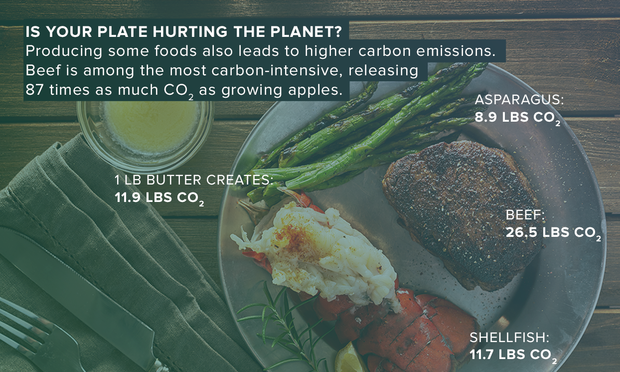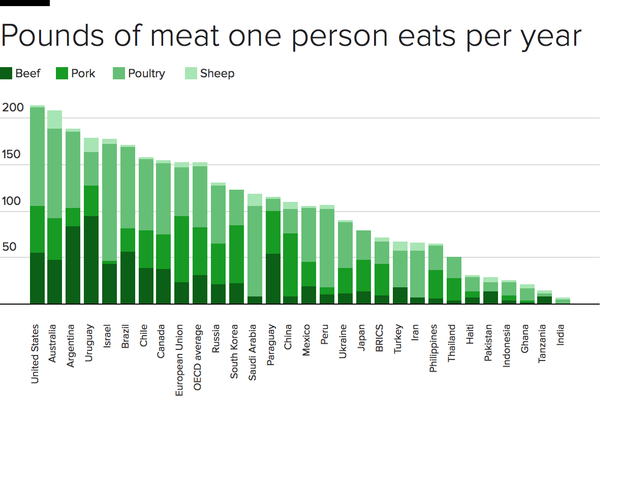Experts link climate change to a wide, and alarming, range of changes on Earth, from melting polar ice, to mega-hurricanes, to wild fires ferocious enough to threaten a major American city. But global warming is also making itself felt on a smaller scale, like your dinner plate.
That’s because rising global temperatures are already affecting the world’s food supply, shifting production of some popular items, like certain kinds of seafood, and raising the price of staples like beef, wheat and coffee. Over the longer term, such trends are likely to alter what Americans eat. And depending on where you live and what you can afford, your food may also be less nutritious, recent studies predict.
Repeated droughts around the world also are destroying enough farm produce to feed 81 million people for a year and are four times more costly for economies than floods, the World Bank found in a recent study. Beyond hindering food production, erratic rainfall patterns and longer droughts are causing a host of problems for cities, including businesses.

It all starts with one indisputable fact: The world is getting hotter. Average temperatures in the decade ending 2015 were 1 degree Celsius (or about 1.8 degrees Fahrenheit) warmer than the 1900s. By 2050, surface temperatures on the planet are predicted to rise between 1.9 degrees and 2.6 degrees Celsius relative to pre-industrial levels, according to research last year from the MIT Joint Program on Global Change.
That will eventually change how and where the four most-eaten grain crops — wheat, rice, maize (corn) and soybean, which combined account for two-thirds of human caloric intake — are produced.
In tropical areas, for instance, manual labor won’t be practical because people won’t be able to harvest crops in the intense heat. In less affluent countries, machine substitutes for labor may not be affordable, said Samuel Myers, a principal research scientist at the Planetary Health, Exposure, Epidemiology, and Risk Program, Department of Environmental Health at Harvard University. Even though more carbon dioxide can boost crop yields initially, the frequency of extreme heat events, like drought, makes farming difficult in areas that lack modern irrigation. And the hotter the planet, the more crops may have to shift toward the arctic poles.
“Where food is being produced is changing, and the price structure is going to change and be hard to predict,” said Myers, who’s co-authored several studies on the topic. “And the actual nutrient profile of the foods we’re consuming is going to be changing. So you might be seeing the exact same food on your plate, but it’s going to be less nutritious than it was 50 years ago.”
That’s because crops like grains and legumes grown in outdoor conditions with higher carbon dioxide concentrations have less zinc and iron, one study led by Myers found.
A look at data from 27 researchers across the globe this summer estimated that, without some changes, crop yields will continue to drop across the four major grains.

For each degree of Celsius and without carbon dioxide fertilization, over the next eight decades average global yields of wheat are projected to fall by 6 percent, rice by 3.2 percent, maize (corn) by 7.4 percent, and soybean by 3.1 percent, depending on the scenario, according to the compilation of research. More acidic and warmer seas are also prompting changes in fish supplies. Even beer and wine are becoming more difficult to produce amid drought, fire and warmer winters.
The changing climate isn’t just altering food production — what we eat is also changing the climate, one of the myriad feedback loops between people and the planet.
The foods that generate the most climate-changing greenhouse gasses, based on their emissions, might surprise some Americans, who eat more meat than any country in the world. Beef, lamb, butter, shellfish, cheese, asparagus, pork, veal, chicken and turkey top the list of foods whose production produce require the most climate-damaging resources to produce.
Total emissions from global livestock account for 14.5 percent of all greenhouse gas emissions, according to a recent report from the Food and Agriculture Organization of the United Nations. Feed production, processing and “enteric fermentation from ruminants” are the two main sources of emissions, representing 45 and 39 percent of total emissions, respectively, according to the report.

In coming years, a warmer climate may actually be a boost for animal and dairy farmers in places like America’s Northeast because of lower heating costs, researchers at Pennsylvania State University found earlier this year. Still, they cautioned, water sources also may become more contaminated with algae blooms, a complicating factor that’s difficult to predict.
“Uncertainties about how host animals, pathogens and disease vectors will respond to climate change are the wild card in predicting the effect of climate-induced changes in animal agriculture in the region,” said Alex Hristov, professor of dairy nutrition, College of Agricultural Sciences, in a statement about his recent study. “Producers will have to be even more diligent in monitoring animal health.”
Prices of beef, one of the most carbon-intensive meats, more than tripled in the past decade. That may have led to fewer Americans eating beef — about 9 percent less beef from 2005 to 2014, according to a March report from the Natural Resources Defense Council.

“Americans have been fighting climate change with our forks,” Sujatha Jahagirdar, policy specialist in NRDC’s Food and Agriculture Program said when the study was released. “As a nation, we have been increasingly eating less beef — a trend that’s not just better for our health, but the health of the planet. By continuing to eat more plant-based food and less animal products, we can continue this forward progress in kitchens across the country.”
Even with the drop, people in the US still eat more beef than almost any region in the world, the NRDC report showed. That’s led to a quest to replace it as Americans eat less.
Wall Street is taking notice, and is looking at companies producing alternative meat substitutes that taste more like the real thing as environmental groups call for lower meat consumption.
“Meatless meats have emerged as an alternative addition to the global food portfolio,” Goldman Sachs analyst Adam Samuelson wrote in a research note.
For instance, Impossible Foods, a maker of plant-based foods, has attracted about $258 million in venture capital from investors including Bill Gates and Google Ventures. The startup’s “veggie burger that bleeds” is finding its way into corporate cafeterias and burger joints.
“Product offerings across the space have expanded in the black bean/veggie burger of decades past to alternative profile sources that have similar mouthfeel, taste and ‘bleed’ of traditional meat without the intermediary of an inefficient animal processing machine,” Samuelson said.

Still, how Americans consume food is also at issue. Last year, the NRDC estimated as much as 40 percent of the food in the U.S. is never eaten. Changing that can help cut down the amount of required food production, a 2014 report from the University of Michigan concluded.
“Increasing the efficiency of our food system by reducing food waste and improving diets is an important strategy for U.S. climate-change mitigation and requires collaborative efforts by businesses, governments, and consumers,” the authors wrote.
— Irina Ivanova contributed to this report.

